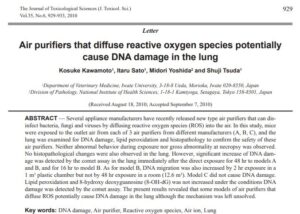Air purifiers that diffuse reactive oxygen species potentially cause DNA damage. Every time I talk about this, You Tube deletes the video.
Air purifiers that diffuse reactive oxygen species potentially cause DNA damage in the Lung.
Several appliance manufacturers have recently released new type air purifiers that can disinfect bacteria, fungi and viruses by diffusing reactive oxygen species (ROS) into the air. In this study, mice were exposed to the outlet air from each of 3 air purifiers from different manufacturers (A, B, C), and the lung was examined for DNA damage, lipid peroxidation and histopathology to confirm the safety of these air purifiers.
PLEASE WAKE UP-THIS IS THE FAKE VIRUS COVID-19 AIR PURIFICATION METHOD THAT IS COMING TO A BUILDING NEAR YOU TO MAKE YOU SICK SO THEY CAN BLAME IT ON THE FAKE VIRUS. CLICK ON THE PHOTO AND READ THIS STUDY.
Reactive oxygen species (ROS ) are chemically reactive molecules that are naturally produced within biological systems. Research has focused extensively on revealing the multi‐faceted and complex roles that ROS play in living tissues. In regard to the good side of ROS , this article explores the effects of ROS on signalling, immune response and other physiological responses. To review the potentially bad side of ROS , we explain the consequences of high concentrations of molecules that lead to the disruption of redox homeostasis, which induces oxidative stress damaging intracellular components. The ugly effects of ROS can be observed in devastating cardiac, pulmonary, neurodegenerative and other disorders. Furthermore, this article covers the regulatory enzymes that mitigate the effects of ROS . Glutathione peroxidase, superoxide dismutase and catalase are discussed in particular detail. The current understanding of ROS is incomplete, and it is imperative that future research be performed to understand the implications of ROS in various therapeutic interventions.
Reactive oxygen species (ROS) are well recognized for playing a dual role as both deleterious and beneficial species. ROS are products of normal cellular metabolism and under physiological conditions, participate in maintenance of cellular ‘redox homeostasis. Overproduction of ROS, results in oxidative stress. Oxidative stress is a deleterious process that leads to lung damage and consequently to various disease states. The lung is a highly specialized organ that facilitates uptake of oxygen and release of carbon dioxide.
Persistent inhalation of the invading pathogens or toxic agents may result in overwhelming production of ROS. Oxidants initiate a number of pathologic processes, including inflammation of the airways, which may contribute to the pathogenesis and/or exacerbation of airways disease.
During inflammation, enhanced ROS production may induce recurring DNA damage, inhibition of apoptosis, and activation of protooncogenes by initiating signal transduction pathways. Therefore, it is conceivable that chronic inflammation-induced production of ROS in the lung may predispose individuals to lung diseases. In this review, we discuss mechanisms of oxidant stress in the lung, the role of oxidants in lung disease pathogenesis and exacerbation.

#1 by Anonymous on July 17, 2020 - 9:31 am
The face masks cause hypoxia, lack of sufficient oxygen and hypercapnia, to much carbon dioxide and will give you permanent brain damage.
Do not wear a face mask aka muzzle.